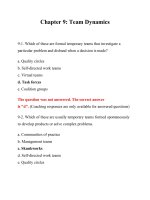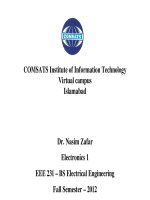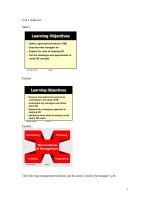Organizational behavior: Lecture 9 - Dr. Mukhtar Ahmed
Bạn đang xem bản rút gọn của tài liệu. Xem và tải ngay bản đầy đủ của tài liệu tại đây (483.22 KB, 40 trang )
Organizational
Behavior
(MGT-502)
Lecture-9
Summary
of
Lecture-8
Personality
Mean how people affect others and how
they understand and view themselves,
as well as their pattern of inner and
outer measurable traits and
Person-situation interaction
Some Major Forces
Influencing Personality
Cultural forces
Hereditary
forces
Individual
Personality
Family
relationship
forces
Social class and
other group
membership forces
Today’s Topics
Emotions
and Mood
Emotions defined
Feelings experienced towards
an object, person or event that
create a state of readiness
–emotions demand attention and
interrupt our train of thought
–emotions are directed toward
something
Emotions- Why Emotions Were
Ignored in OB
• The “myth of rationality”
– Organizations are not emotion-free.
• Emotions of any kind are disruptive to
organizations.
– Original OB focus was solely on the
effects of strong negative emotions that
interfered with individual and
organizational efficiency.
Components of
Attitudes
• Cognitive -- thinking
• Affective -- feeling
• Behavioral -- doing
What Are Emotions?
Affect
Affect
AAbroad
broadrange
rangeof
ofemotions
emotions
that
that people
peopleexperience.
experience.
Emotions
Emotions
Intense
Intensefeelings
feelingsthat
thatare
are
directed
directedat
atsomeone
someoneor
or
something.
something.
Moods
Moods
Feelings
Feelingsthat
thattend
tendto
tobe
beless
less
intense
intensethan
thanemotions
emotionsand
and
that
thatlack
lackaacontextual
contextual
stimulus.
stimulus.
Model of attitudes and
behaviour
Beliefs
Attitude
Feelings
Behavioural
intentions
Behaviour
Emotional
episodes
What Are Emotions?
Emotional labor
A situation in which an employee
expresses organizationally desired
emotions during
interpersonal transactions.
Emotional labour defined
The effort, planning and control
needed to express
organisationally desired
emotions during interpersonal
transactions
Emotional labour issues
• True emotions leak out especially
with low emotional adaptability
• Emotional dissonance causes
stress
• Display norms vary across cultures
Felt versus Displayed
Emotions
Felt emotions
An individual’s actual emotions.
Displayed emotions
Emotions that are organizationally
required and considered appropriate
in a given job.
Emotion Dimensions
• Variety of emotions
– Positive
– Negative
• Intensity of emotions
– Personality
– Job Requirements
• Frequency and duration of emotions
– How often emotions are exhibited.
– How long emotions are displayed.
Emotions
•
•
•
•
•
•
•
Anger
Contempt
Fear
Frustration
Happiness
Hate
Hope
• Jealousy
•
•
•
•
•
•
Joy
Love
Pride
Surprise
Sadness
Enthusiasm
Six Universal Emotions
Happiness
Fear
Surprise
Anger
Sadness
Disgust
Emotion Continuum
• The closer any two emotions are to
each other on the continuum, the
more likely people are to confuse
them.
Happiness
Surprise
Fear
Sadness
Anger
Disgust
Facial Expressions Convey
Emotions
Emotions and
Emotions and
Organizational
Organizational
Behavior
Behavior
Felt
Felt
Emotions
Emotions
Emotional
Emotional
Labor
Labor
Displayed
Displayed
Emotions
Emotions
Can People Be
Emotionless?
Alexithymia (Greek… “lack
of emotion”
Gender and Emotions
• Women
–
–
–
–
–
Can show greater emotional expression.
Experience emotions more intensely.
Display emotions more frequently.
Are more comfortable in expressing emotions.
Are better at reading others’ emotions.
• Men
– Believe that displaying emotions is inconsistent with the
male image.
– Are innately less able to read and to identify with others’
emotions.
– Have less need to seek social approval by showing
positive emotions.
Emotional Intelligence
EI refers to an assortment of noncognitive skills, capabilities, and
competencies that influence a
person’s ability to succeed in
coping with environmental
demands and pressures.
Emotional intelligence
dimensions
Selfawareness
Social
skill
Emotional
intelligence
Empathy
Selfregulation
Selfmotivation









